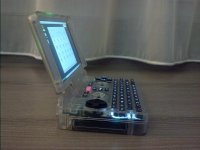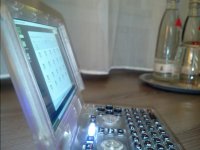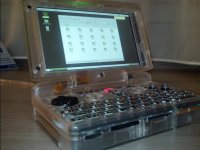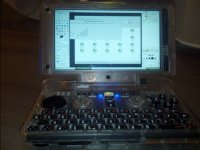It has more to do with incompetence, not with issues. I've never heard of a hardware project that took so much time, even if it only was a "hobby" project.
How many projects with that size have you followed?
I am not aware of ANY hobby project that's nearly as complex as the Pyra.
Do you know any hobby projects that involve a 12-layer PCB with a really small size and such a modern SoC? I haven't seen one.
The OMAP5 is A LOT more complex than the OMAP3 in hardware design. Just the software that TI suggests to run simulations upfront before even starting production costs 90k EUR.
Please point me to remotely complex projects that's being run by just a bunch of people. I'm happy to learn something new.
You might not realize that there are many, many, MANY little things that are customs solutions, which are anything but easy.
Yes, we could've simply got some reference design for a mobile device (as GPD, JXD, many chinese tablets, etc. do), change the layout a bit and be done with it.
That would be easy.
What's different?
Here are some examples:
- We've got two MicroUSB ports and want to be able to use both for charging. Sounds easy? Well, yes, at first. But there's no charger chip out there that actually supports TWO USB ports. Addtionally to that, USB needs to negotiate the maximum allowed current... and the USB protocol needs to work as well. No easy task, and a pure custom solution.
- Similar are the SD-Card slots: The OMAP5 doesn't support as many SD Card / eMMC-Slots we're offering. So we need some muxing to be able to handle that. That's also a custom solution that doesn't work out of the box.
- Design which supports a replaceable CPU board in that small footprint? Also doesn't exist.
Additionally, it doesn't help that the OMAP5 isn't supported that well by TI.
There are many unfinished drivers and other things. Remember we needed to use a rotator chip as TI's implementation of TILER to rotate the screen slowed it down to 10 - 12fps?
We trusted them when they told us TILER is not meant to rotate a full screen. So we looked for the chip.
Well, finding the chip, implementing it and getting it almost to work (without VSync) took about 6 - 7 months. Then zmatt came in and fixed the TILER, and suddenly it worked without the chip.
That was great, yes, but it did cost us quite a few months, and we certainly didn't expect that issue.
An it is still under development. If you have a closer look at what happened in the last three month (one issue fixed, two new came up plus some additional and unplanned changes) you can calculate, that the Pyra is also not released within the next 6 month.
Maybe. Maybe not. Depends. The list of issues is getting smaller, we're fixing more and more stuff.
We're coming closer, we're not stepping backwards.
But everyone in this forum is lurking for the release date next week, because of his birthday, Christmas or easter.
Yes? I see a lot of people who post here anticipate the release, knowing it will take as long as it will take.
And only a few who are getting really impatient.
Now to come back to incompetence. Why this all happens? The long development, the delayed project. And it is delayed. ED said: When we have 1000 preorderers, we will start mass production.
I guess you should reread the post. It says that we've got the funds for the full mass production when we got 1000 preorders.
It doesn't say we will start the mass production as soon as we have 1000 preorders (that wouldn't make any sense).
There is a lack of knowledge about project management. There are for example, no requirements managed. This is the reason why it took so much time with the keymat. Defining a force that is needed to press a key. Tell company you want this force. What really happened? I want it stronger. I want it weaker. No stronger again. Stronger. A little bit weaker now. OK, now I want coated. Coat is to thick.... and so on.
Sure. I didn't know you were with me when all of that happened.
Here's what really happened:
I'm ordering the keymats from an austrian company (production happens in China though, as there are no production companies doing that in Europe).
I got some testing samples (with exact forces on them) so I could give them the exact requirements (force needed, travel distance needed), which they told the chinese company.
So much for your theory that we didn't give clear requirements.
What happened? The keymats we received had a too high travel distance and needed too much force.
Sadly, neither the austrian company nor I had the specific measurement machine to accurately tell what was wrong with that.
So we assumed what we got was what we ordered (they never had any issue with that chinese company before, and they're regularly working with them) and therefore lowered the travel distance a bit as well as lowering the required force.
The result was that the travel distance was too little. Force couldn't really be tested, as the carbon pads did make the contact with the PCB too soon.
That's when I visited them, as something was clearly off here.
At that time, they had bought a 3D scanner for exact measurements, so we checked the keymats we got.
The result: The travel distance of the first keymat did NOT meet our requirement (it was 1,2mm instead of the requested 0,9mm), so our first change (to 0,8mm) was wrong because of that.
The new one was correct (as we could measure now).
We couldn't really check the force though (sadly), but the austrian company is buying the tools for that right now so we can make sure our requirements are set.
Another issue was, as you mentioned, all the coatings:
While the keymat manufacturer has produced a lot of keymats, they NEVER produced a keymat like that.
A keymat that needs various coatings to we have semi-transparent buttons with different colors AND plastic tops on top?
There's a special coating that prevents air bubbles to appear when the tops are glued onto it.
As it turned out, that coating affected the keymat material. They've never used it before, so that was something they also didn't know.
So they now made a stencil layer so that the coating affecting the materials is ONLY on the buttons, not anywhere else.
How would you have handled that?
Would you have spent 50k for measurement devices so you can check the keymats yourself our would you have trusted you got what you ordered?
And this takes sooo much time and cost a LOT of money.
Yes and no.
Yes: It takes time - but only because the requirements have not been met and I wasn't able to check that.
No: It cost less money, as it wasn't our fault, so the changes to the molds and the later revisions have been paid by the chinese company.
To speed things up, we could've done various versions at the same time - which means we would've needed multiple molds for 10k EUR each.
That would've been costly indeed.
So 200€ per pyra are only paid because of stupidity.
You know a company that can create the full Pyra for 200k EUR?
Awesome, please introduce me to them.
I actually asked a couple of companies in Germany. The offers I received was about 150k EUR for the PCB design and 200k EUR for the case and molds.
And that's without a keymat yet.
That's about twice the budget we used for the Pyra.
And it is stupidity. These are exactly the same problems the Pandora project had. Lessons NOT learned!
Yes and no.
Yes: The Pandora had huge delays with the case design as well. The problem is: There's no budget to use the best company available. I've got a plastic injection company just round the corner from my home - but I cannot afford 200k EUR for the case and molds (we're getting them for 60k EUR). So yes, it takes longer, as they are certainly not as experienced as a huge company in Germany, but it is affordable.
Lessons NOT learned?
Well, I moved to European companies as I can visit them easily when there are any issues, which has proved out to be a good idea so far.
Sadly, that doesn't mean that everything works as smoothly as you think.
What will you do if the companies are not delivering as promised?
Switch to a different one half-way through, hoping they will be better (and having to restart and lose the money you paid so far?)
If I had 1 Million EUR funds, I would've probably done that, or used more expensive companies in Germany right from the start.
The funds were never there though, given its size, it's a low-budget project.
And please no: Best product as possible posts.
One note: I never stated that. That's mostly coming from community members.
I am just stating I want it to be AS GOOD as possible (which doesn't mean it'll be the best product).
It will have issues, downsides, sure. We'll have a lot of compromises here and I plan on improving the case later when the Pyra is selling well (it can be made at least 3 - 4mm thinner, but would need some redesigns that require new molds).
The case is changeable though, so I can offer it to everyone who already has a Pyra at that time.
However, what we're fixing are showstoppers. A gaming device where the DPad doesn't feel good is just not feasible.
A case where the shoulder buttons aren't properly working is also not acceptable.
We ARE doing the last tweaks that NEED to be done. Not the ones that would be NICE to be fixed.
You can create the best products without so many iterations.
Yes, though that depends on the complexity and the available sample layouts.
As metioned: Intel, Rockchip, etc. all provide sample layouts which you can copy 1:1 onto your layout and most likely have a fully working product right from the start.
We have the schematics from the uEVM, but that doesn't have any batteries included, only one SD Card slot, a totally different power circuit, etc.
So we had to do that completely ourselves - whereas others can just use the existing circuits.
I work in R&D department. When have one! hardware designer. He creates an B-Sample, then we try out to find ALL the problems, not one after every new pcb run, then there is near-series production run, and after that, the product is sold 100.000 times a year! And it is in cars where you have special requirements to safety and security. So prototype, near-series, series. That's it. No more PCB-runs....
Yes. And?
That doesn't say anything about the complexity of the stuff he's doing.
As Audi is in Ingolstadt and I know many companies that produce stuff for Audi, I know quite some designers there as well.
Car sensor systems, for example?
The hardware usually is a fixed SoM (system on module) which has everything you need, the sensors are connected to it and the software is even a universal software used by many different car manufacturers and just gets the branding changed and features enabled / disabled.
We don't have a SoM, we had to CREATE our own one (that's the CPU board).
Another aspect in the automotive sector: There's a lot of space and things are huge.
Often it's possible to use 2-layer PCBs, sometimes 4-layer PCBs. And you usually don't need to use small footprint BGAs, which means that you can easily modify connections, replace complete parts, etc.
So with one sample, you can often rewire things and change parts until everything works as planned and then use a prototype for testing.
With a 12-layer PCB with BGAs, it's simply not possible to change traces that are below a BGA or inside the PCB.
You can only change it, produce more PCBs and see whether that fixed it.
Additionally, things are REALLY complex here. If the battery readout in the OS is wrong, what's the reason?
Hardware issue? Maybe. But is it the Palmas, the charger chip, the switcher for the USB port?
Or is it part of a software issue? Maybe. But for which driver?
It's not that easy to find out.
Feel free to ask your hardware guy whether he ever needed to design such a complex device as the Pyra (one 12-layer PCB, one 4-layer PCB and a 2-layer PCB) with so many features and customizations at once.
There's one important thing you mentioned:
"Special requirements to safety and security".
That means that things are LESS complex and as simple as possible (depending on the needed features).
Instead of ONE system that does everything, you usually create systems working independently for themselves (sensors, etc.) and then combining them into the full system with various communications.
It's WAY too dangerous to have ONE system handle too much. Which is the total opposite of what we do with the Pyra.
[doublepost=1490214678,1490212594][/doublepost]BTW: I received a first version of aTc's PyraOS working on the current prototypes yesterday.
Just found the time to install and boot it.

I'm currently at a hotel near Frankfurt, so I don't have a good camera with me (only my old Droid4), so the screen looks blurry... but in reality, it REALLY looks awesome!
BTW: I REALLY do love the viewing angle of the LCD.
Looking at it sideways doesn't change the brightness or readability at all.
Here are the quick snaps:











